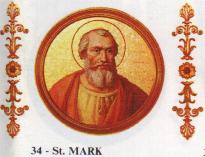
Feastday: October 7
Death: 336
Pope, successor to St. Sylvester I , elected January 18, 336. He was the son of Priscus and a priest of Rome. During his pontificate he erected two basilicas on land donated by Emperor Constantine I. He died in Rome on October 7 after only eight months. His cult is now confined to local calendars.
Pope of the Catholic Church
This article is about the pope of Rome. For Pope Mark I of Alexandria, see Mark the Evangelist. Not to be confused with Mark Pope.
Pope Mark (Latin: Marcus) was the bishop of Rome from 18 January to his death on 7 October 336.
Little is known of Mark's early life. According to the Liber Pontificalis, he was a Roman, and his father's name was Priscus. Mark succeeded Sylvester I as pope on 18 January 336.
Some evidence suggests that the early lists of bishops and martyrs known as the Depositio episcoporum and Depositio martyrum were begun during his pontificate. According to the Liber Pontificalis, Pope Mark issued a constitution investing the bishop of Ostia with a pallium and confirming his power to consecrate newly elected popes. Likewise according to the Liber Pontificalis, Pope Mark is credited with the foundation of the Basilica of San Marco, a basilica in Rome, and a cemetery church over the Catacomb of Balbina, just outside the city on lands obtained as a donation from Emperor Constantine.
Mark died of natural causes on 7 October and was buried in the catacomb of Balbina. In 1048 his remains were removed to the town of Velletri, and from 1145 were relocated to the Basilica of San Marco in Rome, where they are kept in an urn under the altar. His feast day is celebrated on 7 October. He is particularly venerated at the Abbadia San Salvatore at Monte Amiata.





